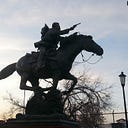Blog #1
These beginning few chapters have began to unravel the twist that is the Mexican Revolution. From a long time of suffering and hardships, to violent revolution that saw many influential figure. The beginning of the 20th century saw the fall of Profirio Diaz, a long term Dictator, and the rise and quick fall of Fransico I. Madero. Madero took over power after the expulsion of Diaz and his subsequent exile. To start, Madero was an unlikely choice for a Revolutionary president, especially since he came from the upper middle class and had accumalted some prior wealth at the expense of others. He was well respected by his workers but one thing that Madero failed to understand was that he was still their master. The campesinos, laborers, and craftsmen were in the Revolution for land reforms, financial security, and a prospect of a new life. Madero may have thought that he was helping the common people by passing the reforms that he did but in reality he was far from in touch with them. Madero’s main support came from those that were not necessarily at the far end of the scale for being revolutionary. He was quite conservative and attracted those that new the revolution was coming but still fought to hold on to the old ways. His middle class supporters were benefited because his reforms put more land into their hands, more money into their pockets and gave them more freedom. However for people like Pancho Villa and Emiliano Zapata, the reforms were not enough and the promises became to little to late. The common people tended to rally around these men that provided a sense of freedom and the ability to change the country by themselves. However Madero’s policies drove a wedge in the revolutionaries and caused some tension, but this tension built into a full out rebellion. Madero was then forced to deal with these threats directly by sending in military support. The military was loyal to the government and when they were sent in they failed horribly to put down the rebellions. This showed that Madero was a weak leader who would do anything to retain his power. Those that were opposed to Madero probably saw this as a start of a new Dictatorship, one that openly attacked the Mexican people, and thus the counterrevolution idea became a major front in this tangled mess. Madero suddenly became the worst of all the evils and open revolution was the only choice for some to combat these oppressive powers. I believe that these years are important because they are the building blocks for the rest of what is bound to happen. These few years create more tension between the different classes of the Mexican people, it causes a rift between popular uprising groups, and it fails to establish a single head of government that cold be trusted. Madero broke the trust of his people and his government, even though this may not have been his intentions his actions spoke louder than his ideas, causing his word to become unreliable and to the common person, almost “oppresive”.
